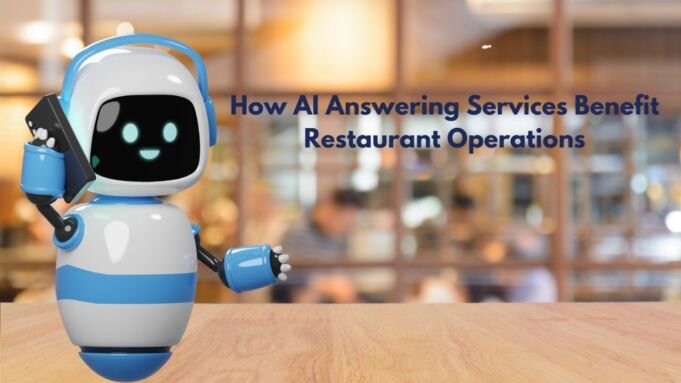These days, restaurants can’t afford to ignore artificial intelligence (AI), it’s become an essential part of running a successful business. AI-powered answering services are changing the game when it comes to how restaurants manage things behind the scenes.
These systems are helping restaurants improve their day-to-day operations, give customers a better experience, and streamline all their communication. A lot is going on under the hood, so let me dive a little deeper into how AI is reshaping the restaurant industry.
Personalized Experiences for Diners
AI and automation enable highly personalized experiences for diners. Imagine a scenario where customers receive menu suggestions designed to their preferences based on previous orders and dining history. 49% of consumers have made impulse purchases after receiving personalized recommendations. This level of personalization not only satisfies customers but also increases restaurant revenue.
A virtual restaurant, also known as ghost kitchens that optimize cost structures can take personalization a step further by offering customized menu items. Customers can mix and match ingredients to make their unique dishes. AI answering services are revolutionizing restaurant operations by providing efficient and reliable customer support solutions.
These services leverage artificial intelligence to handle customer inquiries, and reservations, freeing up staff to focus on other essential tasks. The AI answering service for restaurants offers numerous benefits including improved customer satisfaction, streamlined operations, and increased efficiency.
Assisting Waitstaff and Enhancing Efficiency
By leveraging AI to support waitstaff and streamline operations, restaurants can create a seamless and efficient dining experience for their customers. The combination of personalized touches and enhanced operational capabilities sets the stage for consistently delighted customers.
Refill Tracking
AI can play a major role in supporting waitstaff and enhancing overall operational efficiency. One key area is refill tracking where AI can keep track of refill the drink, and other essentials. This frees up the waitstaff to focus on providing attentive service rather than constantly monitoring tables.
Shift Organization
Improving operational efficiency extends to the back-of-house as well. AI assists in organizing shifts and ensuring optimal staffing levels during peak hours. This not only enhances the customer experience by maintaining appropriate staff-to-customer ratios but also optimizes the restaurant’s cost structure.
Interactive Digital Menu for Restaurant

Restaurants can develop digital menus with built-in virtual assistants. These AI-powered menus provide real-time information about ingredients, nutritional value, and allergen warnings. Consumers can explore menu options while waiting for their orders, freeing up the waitstaff’s time. AI-powered menus can increase order value.
Marketers benefit from AI-generated insights collected during interactions with customers. Understanding customer preferences allows for targeted promotions and menu adjustments. AI-generated insights can boost marketing ROI.
Identifying Repeat Customers for Enhanced Service
AI devices equipped with facial recognition capabilities identify repeat customers. AI devices can identify repeat customers with 95% accuracy. By analyzing past orders, preferences, and behaviors, restaurants anticipate customers’ needs. Personalized experiences extend beyond the venue, even with high staff turnover.
AI ensures that repeat customers receive seamless service. Whether it’s their favorite dish or dietary restrictions, the system anticipates requirements improving overall satisfaction. AI ensures that repeat customers receive seamless service which can boost satisfaction.
Streamlining Reservations and Waitlist Management
By harnessing the power of AI in reservation and waitlist management, restaurants can streamline their operations, improve customer satisfaction, and maximize their seating utilization. This approach to managing activities sets the stage for a truly exceptional dining experience.
AI-Powered Reservation Systems
Restaurants can take their reservation and waitlist management to new heights by integrating AI chatbots and virtual assistants. These AI-powered systems handle a variety of tasks from accepting reservations and managing cancellations to maintaining the waitlist and optimizing table turnover.
By providing a seamless, automated reservation experience, customers are less likely to forget or cancel their bookings. The chatbots can also send timely reminders to customers, further decreasing the likelihood of no-shows.
Additionally, these AI systems can optimize table allocation, ensuring the restaurant’s seating capacity is utilized to its fullest. The algorithms analyze historical data and real-time information to predict peak demand periods and allocate tables accordingly. This level of optimization minimizes wait times for customers and maximizes revenue for the restaurant.
Predictive Waitlist Management
Going beyond reservation management, AI also plays a crucial role in managing the restaurant’s waitlist. By analyzing historical data on customer arrival patterns, party sizes, and average dining durations, AI can accurately predict peak hours and allocate resources accordingly.
The system can provide accurate estimates of wait times, keeping customers informed and setting appropriate expectations. This not only enhances the customer experience but also allows waitstaff to focus on providing attentive service rather than constantly managing the queue.
Moreover, the AI-powered waitlist management can integrate with the reservation system, seamlessly transitioning customers from the waitlist to their table. This end-to-end automation ensures a smooth and efficient flow of operations, reducing friction and frustration for both customers and staff.
Enhancing Kitchen Efficiency and Inventory Management
AI’s impact on restaurant operations extends beyond the front-of-house activities, reaching deep into the kitchen and inventory management. Through AI-powered inventory monitoring systems, restaurants can maintain tight control over their ingredient supplies and automate the replenishment process.
These AI-powered systems continuously track inventory levels, analyzing historical usage patterns and sales data to predict when supplies need to be restocked. By ensuring that the right ingredients are available at the right time, restaurants can minimize disruptions to their menu offerings and avoid costly waste from spoilage or overordering.
In addition to smart inventory management, AI algorithms can also play a role in optimizing recipes and ingredients. By analyzing historical recipe data, AI can suggest ingredient substitutions or portion adjustments that maintain the desired flavor profile while reducing costs.
AI can identify opportunities to use less expensive alternatives, adjust portion sizes, or streamline preparation methods without compromising the dining experience. This level of recipe optimization helps restaurants maintain their profit margins while continuing to delight customers.
Comparison Table: AI vs. Traditional Restaurant Operations
Here is the comparison table that differentiates AI-powered and traditional operations as mentioned below:
| Feature | AI-Powered Operations | Traditional Operations |
| Personalization | Highly personalized experiences based on customer data | Generic, one-size-fits-all approach |
| Ambient Music | AI-curated playlists tailored to the dining atmosphere | The static, pre-programmed music selection |
| Refill Tracking | Automated refill monitoring, freeing up waitstaff | Manual monitoring and replenishment |
| Shift Organization | AI optimizes staffing levels for peak hours | Fixed staffing, potentially leading to over/understaffing |
| Digital Menus | Interactive menus with real-time information and virtual assistance | Static, printed menus with limited information |
| Customer Insights | AI-generated insights for targeted promotions and menu updates | Limited customer data, resulting in less personalized offerings |
| Facial Recognition | Identifies repeat customers, enabling anticipatory service | Reliance on staff memory and notes for returning customers |
| Reservation Management | AI-powered chatbots handle reservations, cancellations, and waitlists | Manual reservation system, prone to errors and longer wait times |
| Inventory Management | AI monitors supplies and predicts replenishment needs | Manual inventory tracking, leading to stockouts and waste |
| Recipe Optimization | AI analyzes recipes and suggests improvements | Fixed recipes, potentially missing cost optimization opportunities |
| Feedback Analysis | AI-powered sentiment analysis for continuous improvement | Sporadic customer feedback, limited insights for menu evolution |
Conclusion
AI-powered answering services are empowering restaurants to step up their game in a big way. By using this technology, restaurants can improve how they run things, keep their customers happy, and stay ahead of the competition.
When restaurants embrace AI, it allows them to create memorable dining experiences for their customers. At the same time, it helps them run things more efficiently and make the best use of their resources.
It’s a win-win – AI lets restaurants give their customers an amazing time while also streamlining the backend operations. Restaurateurs who adopt this technology are setting themselves up for success in today’s competitive industry.
FAQs
How Secure Is AI Handling Customer Data?
AI systems prioritize data security, with encryption protocols safeguarding customer information. Restaurants should choose reputable AI service providers and comply with privacy regulations.
Can AI Replace Human Interaction Completely?
While AI enhances efficiency, human interaction remains crucial. AI complements, rather than replaces, waitstaff. The goal is to create a harmonious blend of technology and personalized service.
What About Training Staff to Use AI Systems?
Proper training is essential. Staff should understand AI tools, their benefits, and how to troubleshoot common issues. Regular training sessions ensure seamless integration and maximize AI’s impact.















